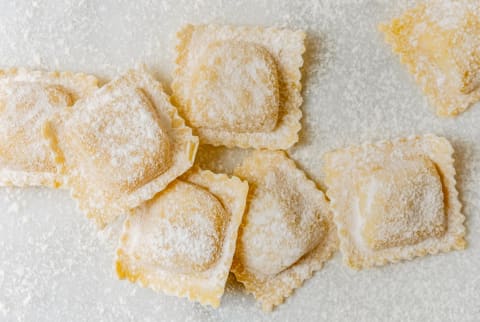Advertisement
Why Women Need Carbs & How To Keep Them From Causing Chaos In The Body


Over the course of a decade of trying to heal my autoimmune disease and gut issues, I've had a love-hate relationship with carbs.
Love because pasta and potatoes are among my desert island essentials. And hate because of the conflicting advice I've been told about what my beloved bowl of Bolognese and side of fries will do to my body.
Some medical professionals treating my Hashimoto's thyroiditis said it was dangerous for women to be super low-carb. Others said I hadn't gone far enough by simply being gluten-free—strict approaches like the autoimmune paleo plan were the only way to get thyroid antibodies under control.
The same pushing of ultra-low-carb approaches came up yet again as I dealt with my next health hurdle: SIBO, small intestinal bacterial overgrowth. Some said I couldn't heal my gut without taking out all grains, while others claimed that removing them would be detrimental to the long-term health of my microbiome.
Meanwhile, I kept hearing from disaffected former keto-philes who had experienced the highs and lows of a restrictive diet and, ultimately, found themselves belly-up by the side of the road as the wagon full of cheese and meat sticks sped away.
So, as I've done with my previous books—The Wellness Project and SIBO Made Simple—I used this experience as an opportunity to fall down the rabbit hole of metabolic health research.
Here's what I discovered in the process of writing my new book, CARBIVORE, that will forever change the way I approach carbs:
Carbs aren't the enemy—especially for women
While many health conditions are caused by chronically high glucose or insulin levels, extreme low-carb approaches can also cause problems.
Studies have shown that going ultra-low-carb can increase levels of cortisol1, our chief stress hormone. For women, cutting carbs overnight and keeping them too low for too long can spur symptoms of adrenal fatigue or HPA-axis dysregulation2, such as sleep problems, difficulty getting up in the morning, poor circulation, or thyroid dysfunction.
We need carbs to both make thyroid hormones3 and convert them into their active form. Particularly for those of us who already suffer from hypothyroidism or Hashimoto's, I've found that a drastic change in carb intake can make our thyroid even more sluggish, leading to more weight gain and fatigue.
Restricting food can also signal to the body that it's time to turn off your sex hormones. We are conditioned to know that times of nutrient scarcity are not ideal for incubating another life. This can manifest in changes to our menstrual cycle4, causing some women to lose their period or not ovulate. For this reason and others5, most doctors do not recommend ultra-low-carb diets for women trying to conceive.
How to enjoy carbs without the blood sugar roller-coaster
These tips can ward off the worst of your blood sugar fluctuations while still allowing you to include grains and starches as part of a balanced diet. There's even a place for dessert too.
Add a "carb companion," especially a nut crunch or seed sprinkle
As a rule of thumb, one of the easiest ways you can prevent refined carbs like white rice and pasta from getting broken down quickly and flooding your bloodstream with glucose is to fall back on your other macronutrients.
"Carb companions" are any ingredients added to your plate that have built-in fiber, protein, and healthy fats. Fat and protein both slow gastric emptying, meaning they make it so the carbs in your meal will reach your small intestines and get absorbed slower.
Fiber has its own superpowers when it comes to your metabolism. You can think of your intestinal wall as a fine-mesh sieve. If you poured a glass of apple juice through it, the liquid would pass easily and leave no residue. But if you were to add some mashed-up apple first? Well, the skins and seeds would clog up the mesh and make any liquid added take longer to make its way through. The result is a slow drip in the bowl versus an unobstructed stream.
The good news is that these carb companions can make your meals even more delicious! The vast majority of the recipes in Carbivore (and on my website) are designed to have built-in carb companions. The nut crunches and seed sprinkles are my favorite since they have fat, protein, and fiber in one tiny package!
Don't drink your sugar
In my years of working with women to overcome their autoimmune issues, I've noticed that sweet beverages seem to be a get-out-of-jail-free card. They stress about buying organic meats and avoiding pasta and bread, but a coconut water with 30 g of sugar gets chugged without a second thought.
But at the end of the day, drinking sugar is far worse than eating sugar. You are much more likely to down a bottle of juice (or a smoothie) in a fraction of the time it would take you to eat a bowl of cereal. This means that its sugars are funneled to your bloodstream that much faster.
Sync your carb intake to your menstrual cycle
Because blood sugar moderation is ruled by the hormone insulin, it can be affected by any other hormonal changes in the body. And for women, these changes happen several times a month by the very nature of our design. A woman's four distinct hormonal phases need to be fed slightly differently to maximize the body's ability to process estrogen, boost progesterone, and monitor all the other hormones.
Focusing on healthy fats and protein can restore energy during your menstrual period. Even if you've been conditioned to ease any discomfort with a hot water bottle and a box of chocolates, sweets will just add more insult to injury.
During your luteal phase, the lead-up to your period, your blood sugar will naturally be at its highest and most volatile. It's an important time to stick to foods that support the liver—beets, leafy greens, fresh herbs—that can help flush excess hormones more quickly. Any sugar and simple carbs (consumed without carb companions) may spike you even more than they normally do at other times of the month.
De-stress at dinnertime
One of my mantras from early in my wellness journey is that if you're stressing about what you're eating all the time, no amount of kale will make you healthy.
When experiencing physical or emotional stress, your primary fight-or-flight hormones cortisol and adrenaline get released into the bloodstream. The result is higher blood pressure, an increased heart rate, and a rise in blood sugar6.
This is why having a regular practice to calm the nervous system is so important for overall carb tolerance—especially for women since cortisol has cascading effects for our whole hormonal motherboard.
Try taking a few big deep belly breaths before you sit down to eat to switch into rest-and-digest mode. Saying a few things you're grateful for before you dive in also helps set the stage. Think of it as a nonreligious grace.
Go "slow carb" in the kitchen
In general, whole foods are always going to be better for your blood sugar than processed foods. Steel-cut oats take longer for your body to convert to glucose than quick-cooking oats and certainly longer than oat milk. Of course, we often choose processed foods for convenience. But opting for whole-food "slow carbs" instead can make a world of difference.
One of my favorite slow-carb techniques that also saves you time is to leave the peels on your vegetables. There is more fiber in the skin of your potatoes and carrots than in their fleshy centers. This makes the skin a built-in carb companion!
The takeaway
In the process of writing my new book, Carbivore, I learned that there are ways to literally have your cake and eat it too. And there are healthier recipes for that cake that won't send you into such a blood sugar tailspin.

Phoebe Lapine is a food and health writer, chef, speaker, and the voice behind the award-winning blog Feed Me Phoebe. She is the author of 4 books, including the forthcoming Carbivore, and her debut memoir, The Wellness Project, which was named by Women’s Health Magazine as the top nutrition read of 2017. An advocate for autoimmune disease and finding food freedom despite chronic illness, Phoebe’s work has appeared in Food & Wine, Marie Claire, SELF, Glamour, Cosmopolitan and Mind Body Green, who named her one of 100 Women to Watch in Wellness. She lives in Brooklyn with her husband and daughter.
More from the author:
How To Make Healthy & Delicious Meals
Check out Learn How To Stock A Healthy Pantry & Meal Prep Like A Pro While Also Saving Time & Money
More from the author:
How To Make Healthy & Delicious Meals
Check out Learn How To Stock A Healthy Pantry & Meal Prep Like A Pro While Also Saving Time & Money

Phoebe Lapine is a food and health writer, chef, speaker, and the voice behind the award-winning blog Feed Me Phoebe. She is the author of 4 books, including the forthcoming Carbivore, and her debut memoir, The Wellness Project, which was named by Women’s Health Magazine as the top nutrition read of 2017. An advocate for autoimmune disease and finding food freedom despite chronic illness, Phoebe’s work has appeared in Food & Wine, Marie Claire, SELF, Glamour, Cosmopolitan and Mind Body Green, who named her one of 100 Women to Watch in Wellness. She lives in Brooklyn with her husband and daughter.
6 Sources
- https://jamanetwork.com/journals/jama/fullarticle/1199154
- https://www.ncbi.nlm.nih.gov/books/NBK537084/
- https://www.ncbi.nlm.nih.gov/pmc/articles/PMC4044302/?_ga=2.11458228.1432764977.1711131338-399153731.1711131336
- https://www.ncbi.nlm.nih.gov/pmc/articles/PMC7053439/
- https://pubmed.ncbi.nlm.nih.gov/29368448/
- https://pubmed.ncbi.nlm.nih.gov/28244581/
Watch Next
Enjoy some of our favorite clips from classes
Enjoy some of our favorite clips from classes
What Is Meditation?
Mindfulness/Spirituality | Light Watkins
Box Breathing
Mindfulness/Spirituality | Gwen Dittmar
What Breathwork Can Address
Mindfulness/Spirituality | Gwen Dittmar
The 8 Limbs of Yoga - What is Asana?
Yoga | Caley Alyssa
Two Standing Postures to Open Up Tight Hips
Yoga | Caley Alyssa
How Plants Can Optimize Athletic Performance
Nutrition | Rich Roll
What to Eat Before a Workout
Nutrition | Rich Roll
How Ayurveda Helps Us Navigate Modern Life
Nutrition | Sahara Rose
Messages About Love & Relationships
Love & Relationships | Esther Perel
Love Languages
Love & Relationships | Esther Perel
What Is Meditation?
Box Breathing
What Breathwork Can Address
The 8 Limbs of Yoga - What is Asana?
Two Standing Postures to Open Up Tight Hips
How Plants Can Optimize Athletic Performance
What to Eat Before a Workout
How Ayurveda Helps Us Navigate Modern Life
Messages About Love & Relationships
Love Languages
Advertisement

These Peanut Butter Cup Protein Bites Make The Perfect On-The-Go Snack
Molly Knudsen, M.S., RDN

Your Grandma's Go-To Supplement Is Once Again Popular (For A Good Reason)
Molly Knudsen, M.S., RDN

These Peanut Butter Cup Protein Bites Make The Perfect On-The-Go Snack
Molly Knudsen, M.S., RDN

Your Grandma's Go-To Supplement Is Once Again Popular (For A Good Reason)
Molly Knudsen, M.S., RDN







